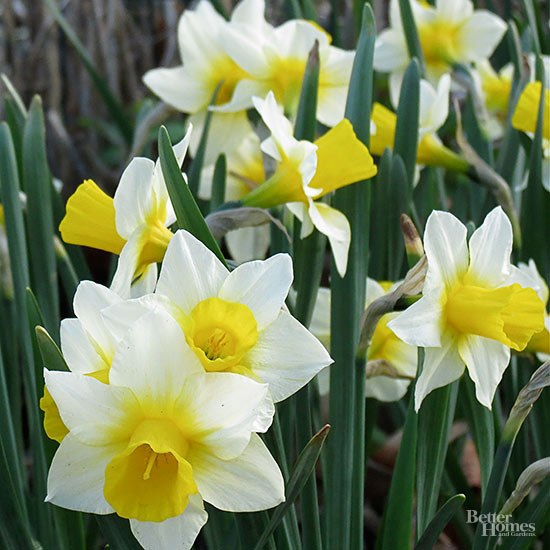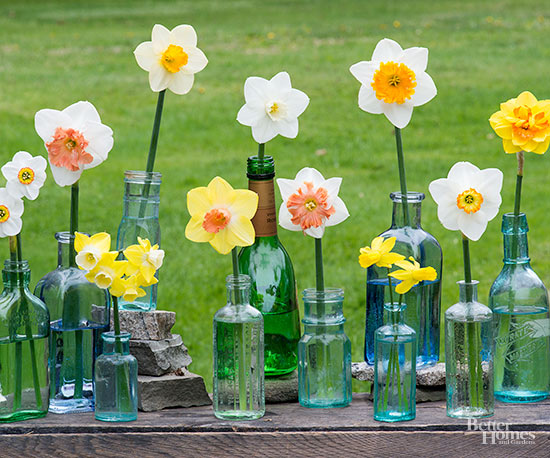






Are they daffodils or narcissus? Both, actually. Narcissus is the botanical Latin name for daffodil. You may have heard them called jonquils, but only one type of daffodil is technically a jonquil, with small clusters of blooms and rounded leaves with pointed tips.
Daffodils grow from bulbs. There are 13 official types or divisions of daffodils, each with different sizes and shapes. Luckily, all prefer the same type of growing conditions and care.
The Royal Horticultural Society of England places daffodils into 13 divisions: trumpet, large-cupped, small-cupped, double, triandrus, cyclamineus, jonquilla, tazetta, poeticus, bulbocodium, split-corona, miscellaneous, and species and wild types known only by their botanical names.
There are wide variations of colors, shapes, and sizes within this world of daffodils, with at least 25,000 registered cultivars and between 40 and 200 different daffodil species, subspecies or varieties of species!
Most people automatically envision bright yellow when they think of daffodils, but they can come in many shades of yellow, white, pink, green, orange, combinations of these colors, and with red rims on the center cups.
Many types produce only one stem with one flower per bulb, while others grow stems with three or more smaller flowers per stem.
Some grow with a wide, flat face instead of a trumpet, while others sport cups with multiple petals or frilly edges.
Daffodil varieties can be early-, mid-, and late-season bloomers. Depending where you live and your spring weather, you may be able to grow daffodils for several weeks by choosing bulbs from each category.
Daffodils grow in most areas of the United States and southern Canada but struggle in cold Zones 2 and 3as well as hot Zone 10.
Many, though not all, daffodils carry a light, sweet fragrance.
With all this variety, why choose just one to grow?
When to Plant: Buy daffodil bulbs in the fall and plant them when the ground temperature falls to 60 degrees F. or colder, usually after the first frost. If you plant bulbs when the temperatures remain warmer, the bulb will begin growing and won't grow again in spring. You can plant bulbs anytime the ground isn't frozen.
Where to Plant: For best performance, plant daffodil bulbs in full sun. Daffodils can tolerate some filtered light or partial shade.
How Deep to Plant: How deep to plant bulbs depends on the size of the bulb. Larger bulbs should be planted deeper, usually 6-8 inches deep. Follow the directions that come with your bulbs. If you don't have directions, dig a hole at least two times and preferably three times deeper than the depth of the bulb.
How Far Apart: The same rule of thumb applies to bulb spacing: About three times the width of the bulb.
Which Way is Up?: Plant the bulb with the wide base down and the pointed nose up. If you accidentally plant it upside down, the bulb will eventually right itself underground.
Design Ideas: Avoid planting bulbs in a single marching line. They look best if you plant them in multiples. Groups of five or 10 in a single space offer impact. You can vary the colors and types, but remember that taller varieties will obscure the shorter ones if they're interplanted.
Water: Daffodils love spring moisture. They should get about 1 inch of water per week in spring growing but almost none during summer and light amounts in the fall and winter. Daffodil bulbs rot when they're in a flowerbed that's regularly irrigated. Plant them where you can basically ignore them during the summer.
Fertilizer: Daffodils need little fertilizer. For a boost, water in fall or spring with a water-soluble formula that contains a larger third number such as 5-10-12, representing potassium. Potassium helps with root development, drought protection, and photosynthesis. It also helps with cold tolerance, so a fall application is best. University research shows that bone meal does not provide much benefit and may attract digging animals.
Critters: Animals may dig but leave the bulbs alone because they contain alkaloid crystals that can leave a bad taste and numbness in their mouths.

Daffodils make spectacular cut flower bouquets. However, freshly cut daffodils emit a chemical that can kill other flowers in the same vase. Before blending daffodils with other flowers, let the cut ends sit in a vase filled with water for about 24 hours to flush the chemical.
Touching the bulb is safe, but a few people find the sap from stems of cut daffodils to be irritating to the skin. Wear gloves when cutting them to avoid irritation.
The only time you may not like daffodils is after they are done blooming. The bulb uses the foliage to capture light and oxygen to build itself back up for next year's bloom, so it's important to leave the foliage in place until it turns yellow or brown. This may take up to 10 weeks. Avoid bending, braiding, cutting or otherwise mutilating the foliage.
Disguise unattractive foliage by planting bulbs between companion perennials or shrubs to help mask the view.
If your bulbs didn't flower well, you may need to move them. The most likely culprits are too much water and/or too much shade. In the fall, dig them and replant them where they get less water and/or more sun.
Remember to mark the locations of any bulbs you wish to move so you can remember where to dig in the fall. Golf tees make unobtrusive and small markers.
Northern gardens have more options when choosing daffodils because they need a chilling period in the ground to produce flowers. In the South, try jonquil hybrids, tazettas, and bulbocodium hybrids. Southern daffodil beds in particular benefit from an application of organic mulch, such as pine straw, to keep the ground cooler and moister.
Always buy bulbs from a reliable source. Avoid buying daffodil bulbs that feel or look shriveled. Bulbs with two points or noses will produce two stems.
If you purchase potted daffodil bulbs from a florist shop in spring, you can try replanting the bulbs in the ground.
Copyright © www.100flowers.win Botanic Garden All Rights Reserved